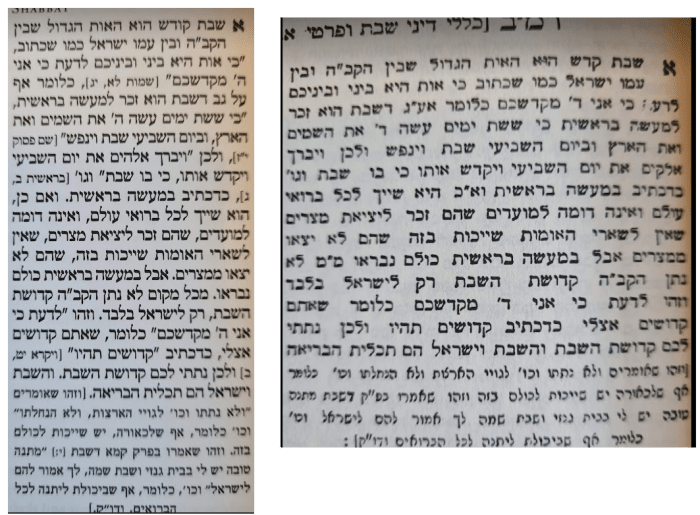Aruch Hashulchan in English: Orach Chaim Chapters 242-292 (Laws of Shabbat)
Edited by Rabbi Ilan Segal, Urim Publications, 2021
As far back as when I was a student at Yeshiva University, I would hear rumblings about how an English translation of R. Yechiel Michel Epstein’s halakhic work the Aruch Hashulhan could revolutionize contemporary Judaism. My sense at the time was that this renewed interest could be attributed in part to the publication of Dr. Haym Soloveitchik’s now-classic article Rupture and Reconstruction: The Transformation of Contemporary Orthodoxy in which he specifically contrasts halakhic rulings of the Aruch Hashulhan with positions that have become more socially accepted. The theory I recall hearing at the time was making the Aruch Hashulhan accessible to the English-speaking Jewish world could popularize halkhically valid alternatives to what people simply took for granted and could ultimately change its conceptions of halakhah and the halakhic process. Of course, no such translation ever materialized.
Now, twenty-seven years since the publication of Rupture and Reconstruction, we find a new volume translating part of the Aruch Hashulhan edited by Rabbi Ilan Segal. According to the acknowledgments, this project “originated many years ago” in a conversation between Rabbi Saul J. Berman and Rabbi Michal J. Broyde.1 We are not told of the nature of this conversation or if the project shared the ambitious goals I mentioned earlier. In any event, this volume is undeniably the product of many years of painstaking work and attention to detail.
Ironically, the first detail I noticed had nothing to do with the English translation but with the included Hebrew text. To my admittedly unreliable eyes, it seems that the font and typesetting were chosen to resemble the “traditional” printed editions of the Aruch Hashulhan.

Of course, the text in the newer edition is far easier to read and converting the paratheneticals originally written in Rashi script to block print is a welcome update.
From what I have read of the translation, I believe this volume succeeds in its goal of finding the delicate balance between crafting a readable translation will remaining faithful to the original text. The editor acknowledges that “obvious typographical and citation errors were corrected” (12), deviations which I hope readers will appreciate.
Perhaps the most pertinent question is who, exactly, will these readers be? R. Segal writes that this volume will, “appeal to both the novice and the scholar” (11). I assume that “scholar” here refers to religious scholars rather than academics because this translation makes no pretense at being a critical edition of the Aruch Hashulhan. Even so, I can understand scholars appreciating the corrected citations more than the translations, which they would presumably not need.
I am more skeptical regarding the utility of this volume for the novice as a halakhic resource. This is in part due to the style of the Arukh Hashulhan which includes discourses on earlier sources and opinions. Those simply looking for final conclusions may sooner reach for the Shulhan Aruch and those interested in more detail may find Rambam’s Mishna Torah easier to read through. While this edition does have a table of contents listing chapters and topics, finding answers to specific questions can be challenging with the lack of an index. Finally, even at over 500 pages, this volume does not contain the entirety of the Aruch Hashulhan on Shabbat; this volume ends at chapter 292 while the Aruch Hashulhan on Shabbat goes up to chapter 416.2 Even if the Aruch Hashulhan provides an enlightening and useful alternative to popular opinions, I believe it may still be difficult for the novice reader to find them, let alone understand the full significance.
My sense is the best audience for this book will be communal rabbis and educators who ordinarily would love to include a wider range of sources in their talks and classes but may not have the time to write out their own translations for an English audience. In educational settings, they would be able to filter out the conclusions from the Aruch Hashulhan or expand on the significance of his interpretations as warranted. I would also suggest that such inclusion in communal halakhic discourse will be essential for the Aruch Hashulhan’s opinions to gain any sort of traction in the observant world’s halakhic sensibilities.
At any rate, we may distinguish any potential utility or influence of this English edition of the Aruch Hashulhan from the quality of its content. Regardless of any implicit or explicit goals, all those involved with this project should be commended for their time, effort, and skill in producing an excellent translation of an under-studied and under-appreciated halakhic work.
I have no idea if this volume will have the impact on the Jewish community imagined by others years ago, but in my opinion, the Jewish world is better off with its publication.
Notes
- R. Broyde recently co-authored Setting the Table: An Introduction to the Jurisprudence of Rabbi Yechiel Mikhel Epstein’s Arukh HaShulhan which indicating a longstanding interest in the Aruch Hashulhan. (I have not seen a copy of this new book to comment further and at $139 on Amazon it’s a bit steep for my budget. However, donations are always appreciated)
- I have seen no indication that more volumes are forthcoming, let alone plans for completing an English translation covering the Aruch Hashulhan